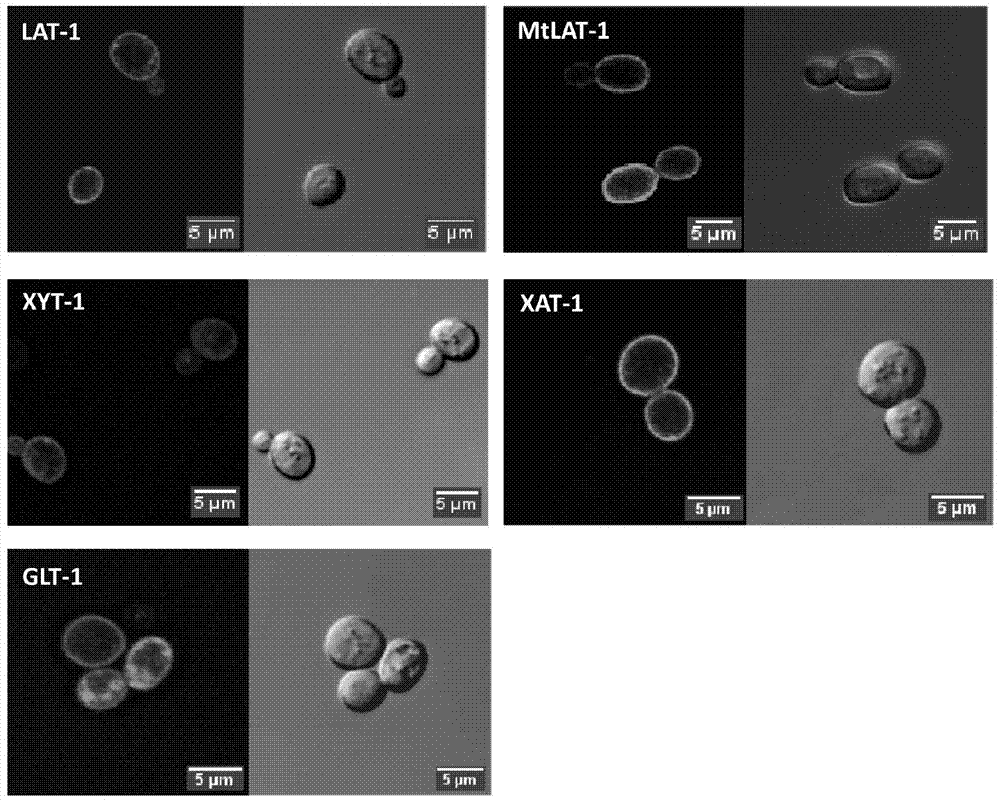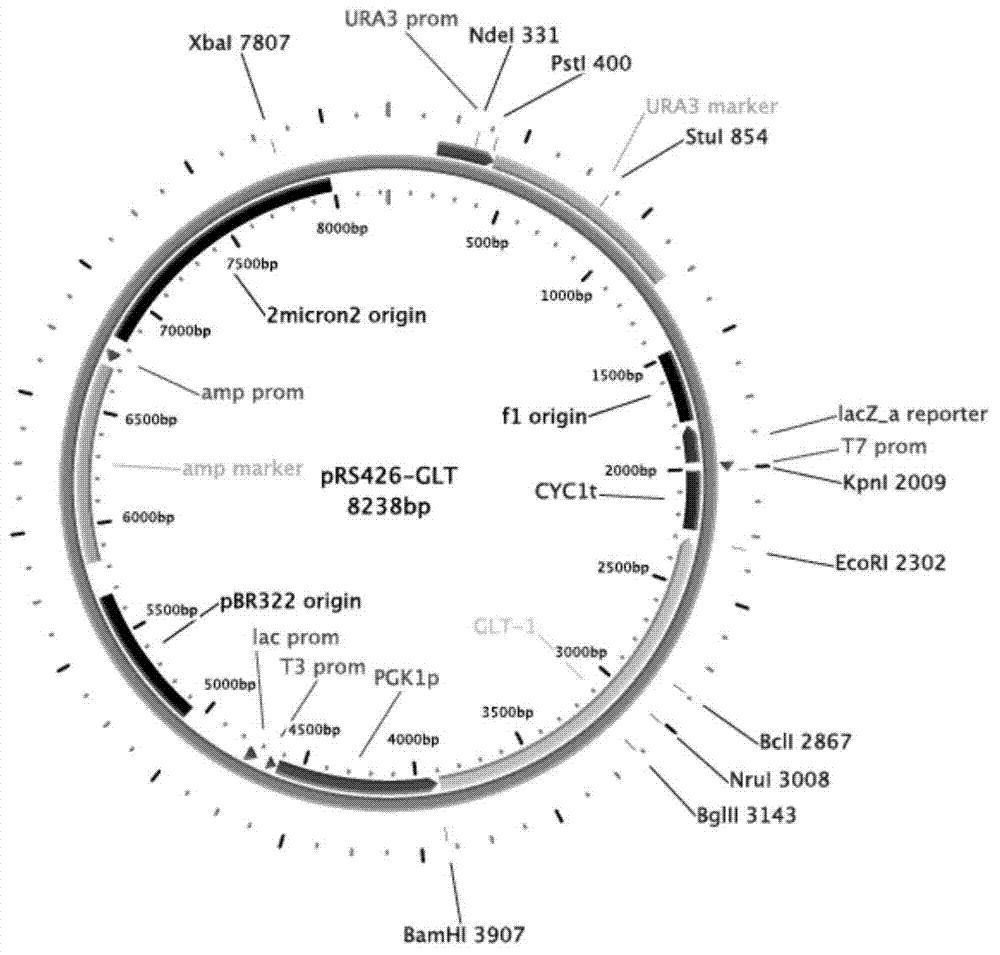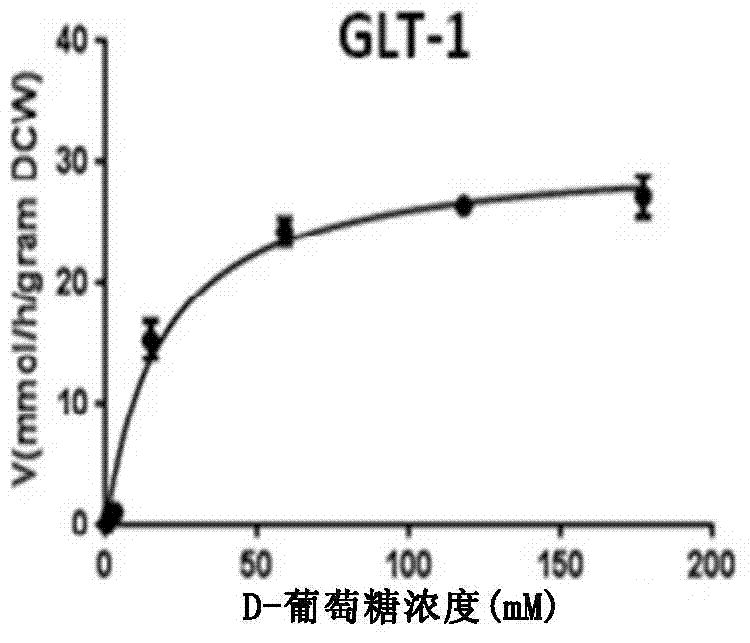Method for promoting microbial cells to transport glucose, xylose and arabinose and application thereof in fermentation of biobased products
A technology of arabinose and cells, applied in biochemical equipment and methods, botany equipment and methods, chemical instruments and methods, etc., can solve problems such as potential changes and unexplained
- Summary
- Abstract
- Description
- Claims
- Application Information
AI Technical Summary
Problems solved by technology
Method used
Image
Examples
Embodiment 1
[0126] Example 1.GLT-1 is a glucose transporter that enables microorganisms to obtain the ability to transport and utilize glucose
[0127] 1. Construction of GLT-1 gene expression vector
[0128] Using primers GLT-F (sequence: 5'-CGCGGATCCATGGGTCTCTTCTCGAAAAAGTC-3') (SEQ ID NO.: 11) and GLT-R (sequence: 5'-CCGGAATTCCTAAACCTCTCCATGGCTTGAGG-3') (SEQ ID NO.: 12) from vein The coding reading frame of the GLT-1 gene was amplified by PCR from the cDNA of the sporozoite. The PCR reaction system was: 5×phusion HF buffer 10μL, 10mM dNTPs 1μL, GLT-F 2.5μL, GLT-R 2.5μL, cDNA 1μL, Phusion DNA Polymerase 0.5 μL, water 32.5 μL. The PCR reaction conditions were as follows: first 98°C for 30s; then 98°C for 10s, 65°C for 30s, 72°C for 1.5min, 35 cycles; finally 72°C for 10min, 4°C for 10min. After the PCR reaction was completed, the PCR product and plasmid pRS426-PGK1 were combined using restriction enzymes BamHI and EcoRI [the plasmid was constructed according to reference (Galazka, J.M.,...
Embodiment 2
[0145] Example 2.XYT-1 is a xylose transporter that enables microorganisms to obtain the ability to transport xylose
[0146] 1. Construction of XYT-1 gene expression vector
[0147] Using primers XYT-F (sequence: 5'-GGACTAGTATGGTTCTGGGGAAAAAGTCAATC-3') (SEQ ID NO.: 13) and XYT-R (sequence: 5'-CCCAAGCTTCTAAACCCTATGGTTAATAACCTT-3') (SEQ ID NO.: 14) from Grain The coding reading frame of the XYT-1 gene was amplified by PCR from the cDNA of the sporozoite. The PCR reaction system was: 5×phusion HF buffer 10μL, 10mM dNTPs 1μL, XYT-F 2.5μL, XYT-R 2.5μL, cDNA 1μL, Phusion DNA Polymerase 0.5 μL, water 32.5 μL. The PCR reaction conditions were as follows: first 98°C for 30s; then 98°C for 10s, 60°C for 30s, 72°C for 1.5min, 35 cycles; finally 72°C for 10min, 4°C for 10min. After the PCR reaction was completed, the PCR product and the plasmid pRS426-PGK1 were combined using restriction enzymes SpeI and HindIII [the plasmid was constructed according to reference (Galazka, J.M., et al....
Embodiment 3
[0150] Example 3.XAT-1 is a xylose and arabinose transporter, enabling microorganisms to obtain the ability to transport xylose and arabinose
[0151] 1. Construction of XAT-1 gene expression vector
[0152] Using primers XAT-F (sequence: 5'-CGCGGATCCATGAAGCCATTTCTGGGGCTC-3') (SEQ ID NO.: 15) and XAT-R (sequence: 5'-CCCAAGCTTCTACGACTCCCGATTACCTCCAT-3') (SEQ ID NO.: 16) The coding reading frame of the XAT-1 gene was amplified by PCR from the cDNA of the sporozoite. The PCR reaction system was: 5×phusion HF buffer 10μL, 10mM dNTPs 1μL, XAT-F 2.5μL, XAT-R 2.5μL, cDNA 1μL, Phusion DNA Polymerase 0.5 μL, water 32.5 μL. The PCR reaction conditions were as follows: first 98°C for 30s; then 98°C for 10s, 65°C for 30s, 72°C for 1.5min, 35 cycles; finally 72°C for 10min, 4°C for 10min. After the PCR reaction was completed, the PCR product and plasmid pRS426-PGK1 were combined using restriction enzymes BamHI and HindIII [the plasmid was constructed according to reference (Galazka, J.M....
PUM
| Property | Measurement | Unit |
|---|---|---|
| affinity | aaaaa | aaaaa |
| affinity | aaaaa | aaaaa |
| affinity | aaaaa | aaaaa |
Abstract
Description
Claims
Application Information
 Login to View More
Login to View More - R&D
- Intellectual Property
- Life Sciences
- Materials
- Tech Scout
- Unparalleled Data Quality
- Higher Quality Content
- 60% Fewer Hallucinations
Browse by: Latest US Patents, China's latest patents, Technical Efficacy Thesaurus, Application Domain, Technology Topic, Popular Technical Reports.
© 2025 PatSnap. All rights reserved.Legal|Privacy policy|Modern Slavery Act Transparency Statement|Sitemap|About US| Contact US: help@patsnap.com



